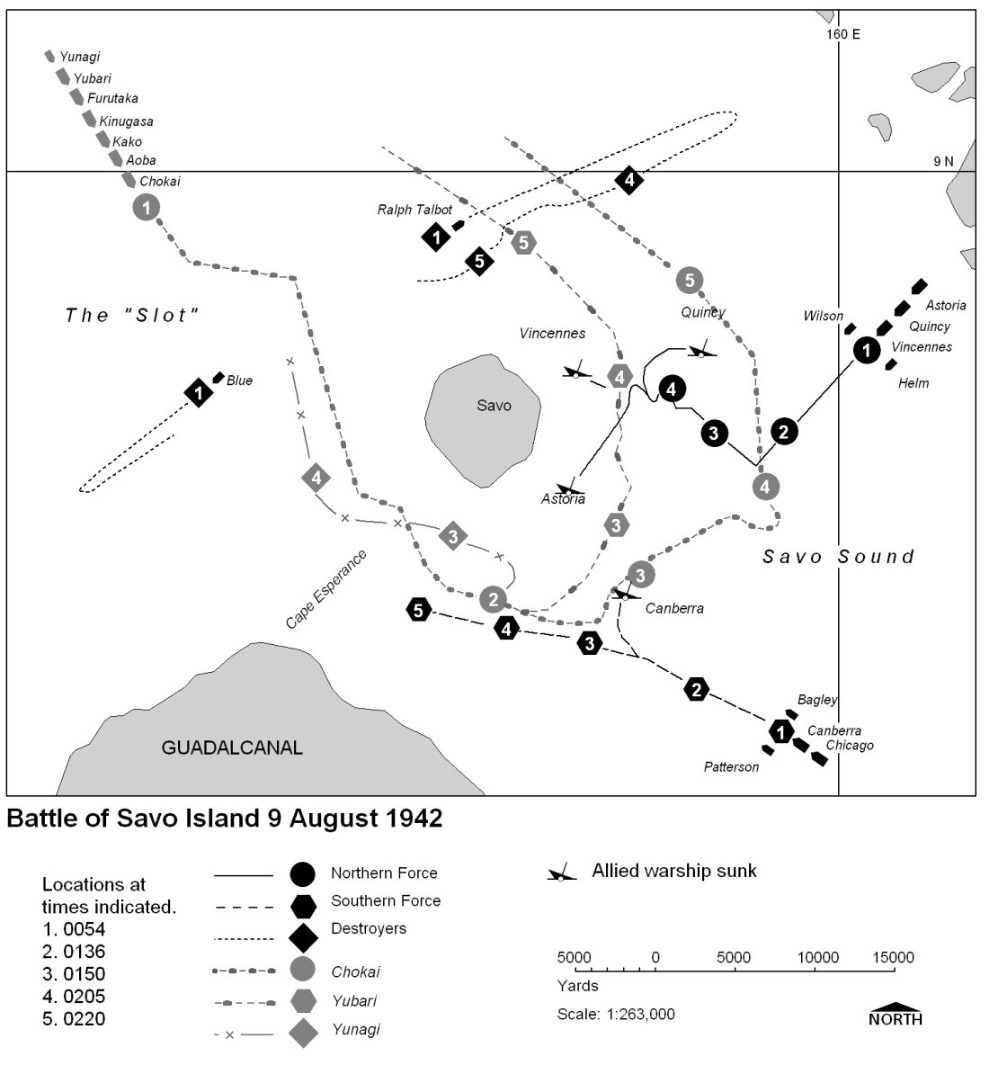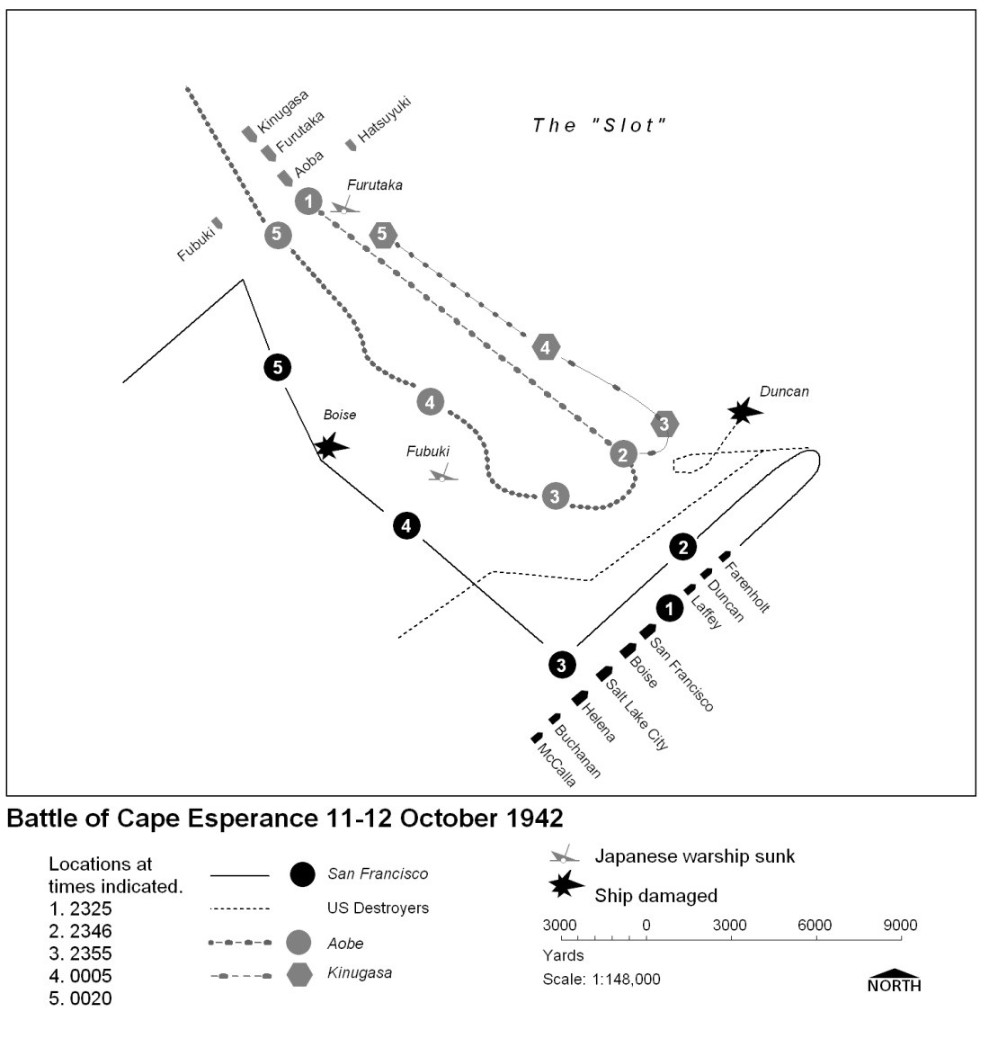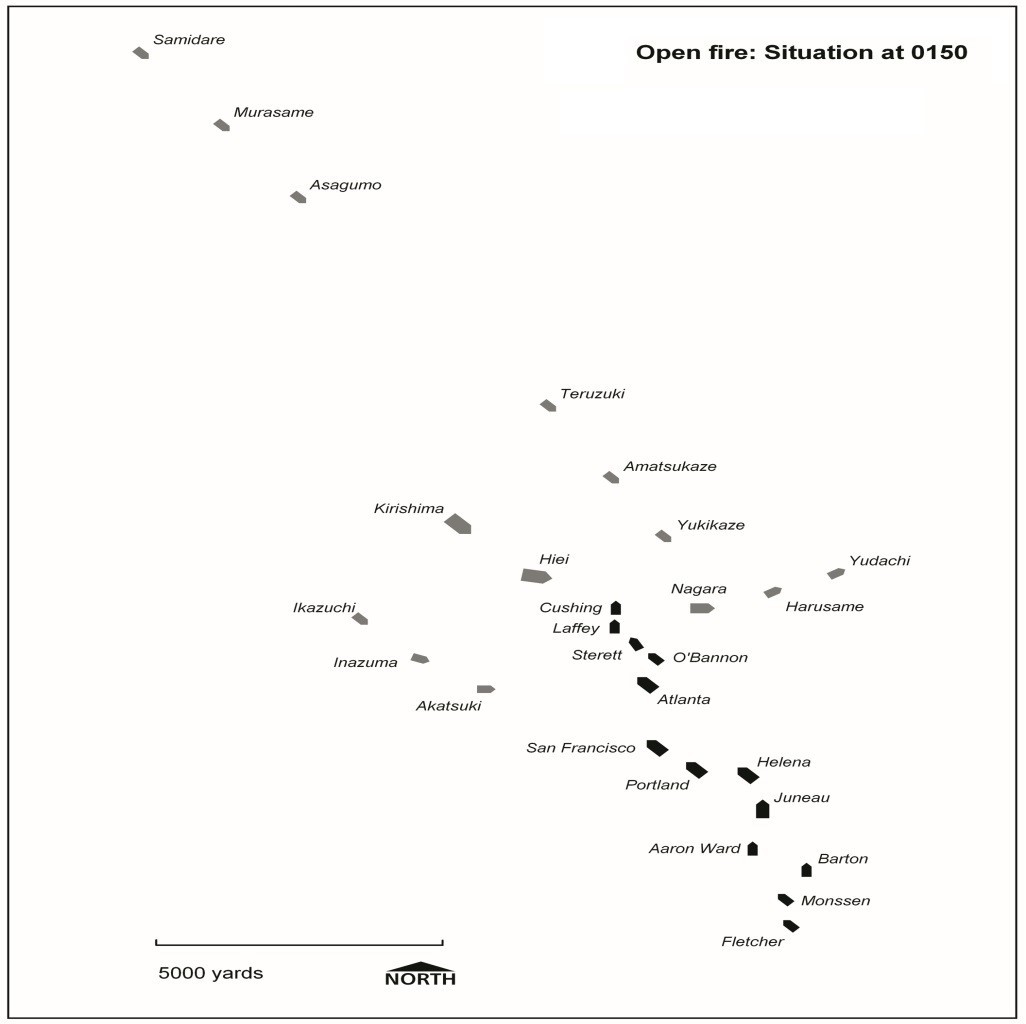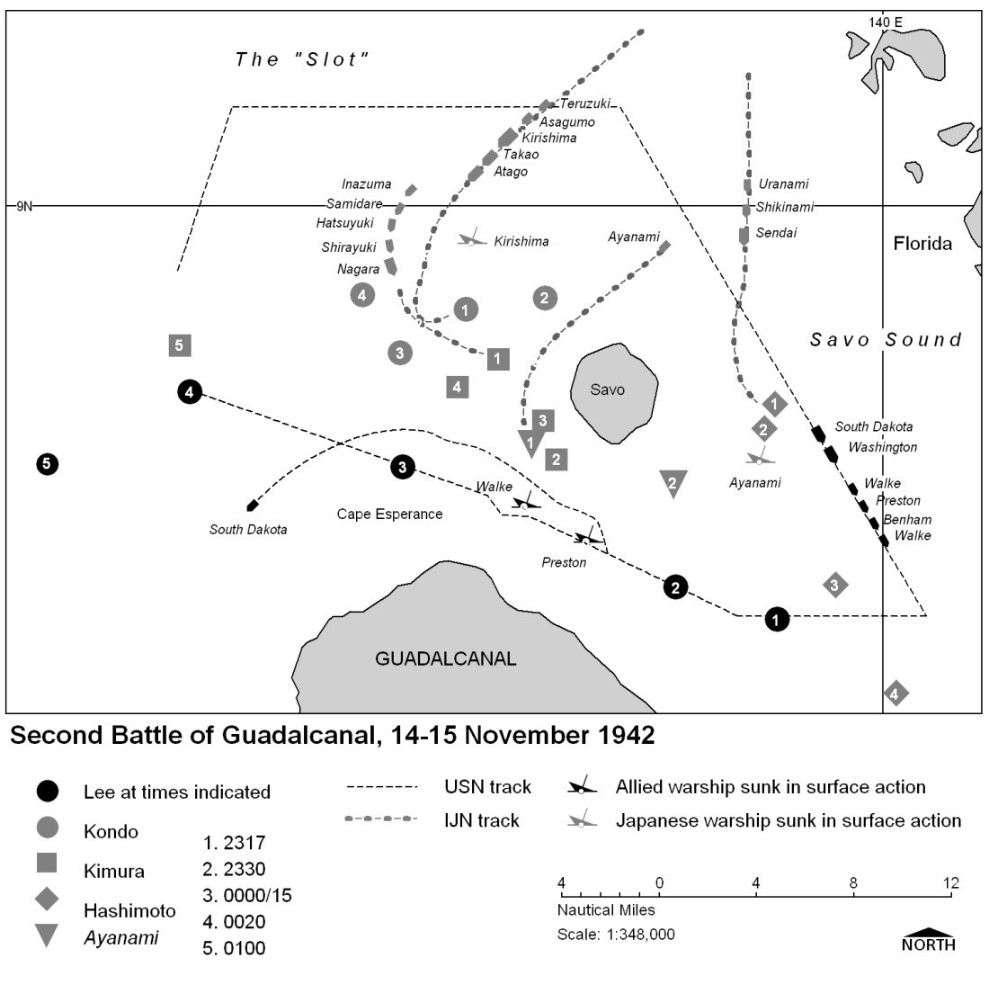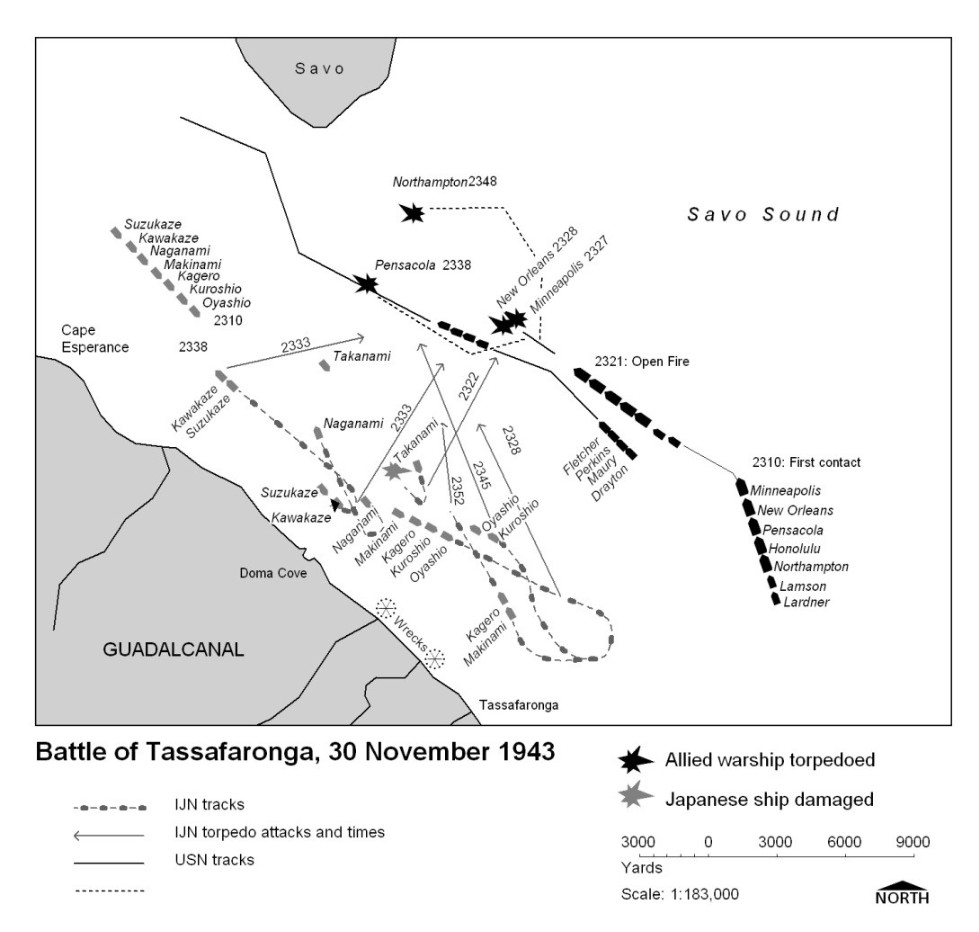Surface Lessons of Guadalcanal
James Young
This essay is a selected submission from the 2017 CNO Naval History Essay Contest. The content of the original essay has been copyedited prior to publication.
Seventy-five years ago this August, the United States Navy (USN) embarked on its first offensive campaign of World War II. Codename Operation Watchtower, the invasion of Guadalcanal was directed by Admiral Ernest J. King despite the reservations of his Pacific Fleet Commander, Admiral Chester Nimitz. Although seizing the airfield on Guadalcanal was simple for the USN, maintaining the sea lines of communications to it proved maddeningly difficult for the USN. This was especially true for the surface warfare community. Beginning with Savo Island (9 August), then proceeding through Cape Esperance (11-12 October), First Guadalcanal (13 November), Second Guadalcanal (14-15 November), and then concluding with the Battle of Tassafronga (30 November), the Imperial Japanese Navy (IJN) provided a sharp tutorial in night surface combat to the USN’s battleship, cruiser, and destroyer crews. The resultant lessons in combat mindedness, command and control, ordnance testing, and the application of technology are still relevant to the modern United States Navy. This essay will attempt to highlight these areas in the hopes that the “tuition” need not be paid again in future conflicts.
Combat Mindedness
Combat mindedness has had many definitions throughout naval history. For purposes of this essay, combat mindedness is a state of being prepared for contact with enemy forces both immediately prior to and during conflict. At the ship level, this is manifest by all crewmembers maintaining vigilance as their default state, the vessel’s material aspects being maintained in readiness and, most importantly, the vessel’s officers being empowered to react reflexively to enemy forces. At the task force level, it is an admiral and his subordinate ship captains understanding the operational situation, their intended mission, and the methods by which their force will inflict the maximum harm upon their opponent. Operationally, it is the understanding that all decisions, from allotting ships to a given task force through deciding senior officer assignments, must serve as means to a campaign’s end. In all cases, combat mindedness can be achieved through the development of a common fighting doctrine, regularly executing ship and task force wide drills, and the dissemination of lessons learned from previous operations.
The Guadalcanal Campaign swiftly highlighted the USN surface community’s lack of combat mindedness. This began with the Battle of Savo Island, in which an IJN force under Vice Admiral Gunichi Mikawa managed to surprise and nearly annihilate a force of American and Allied cruisers screening the transports off Guadalcanal. Despite Japanese floatplanes from Mikawa’s force being discovered by radar and lookouts an hour and a half before first surface contact, no general alarm was raised across the task force. Nor did this situation change once the Japanese vessels were sighted and engaged by picket destroyers screening the two separate groups of heavy cruisers. Indeed, it was only after the “Southern Group” (cruisers USS Chicago and HMAS Canberra accompanied by the destroyers USS Patterson and Blue) were directly engaged at 0143 that any American vessels began to react. Of said reactions, only the USS Vincennes began to come to General Quarters, with the USS. Astoria and Quincy not even taking that step before Mikawa’s forces began engaging them at 0200. Although the American cruisers managed to land some blows, to include a critical one that destroyed Vice Admiral Mikawa’s charts of the area, fifteen minutes later the three heavy cruisers were all out of action.
[1]
The lack of combat mindedness within the USN’s forces at Savo Island was readily apparent in the battle’s aftermath. In the Southern Group, despite having watched Canberra destroyed and being torpedoed herself, Chicago’s Captain Bode made no radio report of being in contact to the Northern Group, his commander Rear Admiral Victor Crutchley (R.N.), or the overall force command Rear Admiral Richmond Turner, USN. In the Northern Group, the captains of Astoria and Quincy did not empower their OODs to react, while Vincennes’s master did not conduct a thorough briefing with his evening watch before retiring. In all three cases, the vessels’ commanders had stood on their bridges for over twenty hours rather than enacting leader rest plans. Lastly, all three American heavy cruisers had flammable materials present throughout their topside spaces. The immediate ignition of these materials by Japanese gunfire made it much easier for the IJN to aim subsequent salvoes at the Northern Force’s cruisers, while the fires’ persistence played a large part in dooming Astoria’s damage control efforts the following morning.[2]
Command and Control
The lack of combat mindedness displayed at Savo Island was exacerbated by problems with command and control (C2). In everything from poor radio communications to inadequate transmission of orders, these issues would persist throughout the Guadalcanal Campaign. To be fair, some of the difficulties lay with the vagaries of tropical atmospheric conditions, faults inherent to World War II-era electronics, and the chaos of night combat. However, the primary factor in the surface warfare community’s uneven performance remained the USN’s lack of nighttime fighting doctrine. This, in turn, prevented American task force commanders from quickly and efficiently developing a fighting plan from a common framework or terminology. As a result, efforts to communicate intent to subordinates were often confusing in tone and language. Unsurprisingly, this combined with deficient radio discipline to result in poor C2 during the subsequent four engagements after Savo Island.
It is necessary to stress that these issues existed long before August 1942. The USN had entered World War II believing that its battles with the Imperial Japanese Navy would be settled by a series of long range engagements in the Central Pacific. The surface fleet had trained almost exclusively for such an event, with commanding officer’s careers often being decided by how well their ships could shoot in staid, repetitive gunnery competitions.[3] Although there had been day and night surface fights in the Dutch East Indies in early 1942, they had gone almost overwhelmingly the IJN’s way. The lopsided nature of these victories and almost complete Japanese air superiority prevented the majority of the USN’s Asiatic Fleet from escaping to Australia. What vessels that did survive were swiftly removed from the operational area due to their obsolescence, with the crews broken up to man more modern ships in theater or new construction working up. Taken altogether, these factors led to the Pacific Fleet being unaware of the IJN’s predilection for and skill in night surface combat prior to Savo Island.[4]
Despite the USN’s performance at Savo, the Pacific Fleet specifically and Navy in general made no effort to examine the lessons from that debacle. This was due partially to the USN’s embarrassment at such a lopsided defeat, but also to ongoing operations and the lack of an established dissemination plan for “lessons learned.”[5] Thus, when Rear Admiral Norman Scott was tasked to stop a Japanese bombardment force at Cape Esperance in October, he did so with a haphazardly assembled force. Moreover, this force was assembled so hastily that Scott barely had time to issue a memorandum of fighting instructions. In this document, Scott was forced to discuss things such as nighttime search tactics, targeting, and radio procedures in detail that the IJN did reflexively due to their doctrine. Scott was then forced to provide clarification en route via signal light in order to clarify issues such as when ships had freedom to fire, what weapons could be employed, and when captains could maneuver their vessels. This process was still ongoing even as the USN force entered Ironbottom Sound off of Guadalcanal.[6]
Unsurprisingly, this scratch plan fell apart upon meeting the IJN. Despite an overwhelming initial USN advantage due to radar, friction imparted by the lack of a common basic doctrine plus poor USN radio discipline allowed the Japanese time to recognize the danger they were in rather quickly. As was the IJN’s usual method, individual captains reacted aggressively with torpedoes, then gunfire as they had been trained. Although the Japanese did not escaped unscathed, their losses were far less than they should have been given the battle opened with the Scott’s undetected task force “crossing the T.”[7] Unfortunately for the USN, the sinking of one heavy cruiser and a destroyer was hailed as a brilliant victory rather than a narrow tactical success. Furthermore, it convinced many flag officers, to include Admiral Nimitz, that the Battle of Savo Island had been an anomaly brought about by a chain of unique circumstances.[8]
Rear Admiral Scott himself did not share this view and immediately began taking vigorous measures to correct his force’s deficiencies. As historian James Hornfischer noted, “Scott had the sole claim to status as a victorious surface-force commander. He had absorbed the lessons of his experience and acted on them with focused seriousness.”[9] The first step Scott took was to develop standard fighting instructions. The second was to make recommendations on what vessels he needed to reinforce his battered task group. Finally, Scott began a rigorous training regimen that emphasized gunnery and ship handling in conditions of limited visibility. For a short time, it appeared that the USN had found its man for the next night engagement with the Japanese.[10]
It was not to be. The USN inexplicably did not modify its personnel regulations to provide leeway to a theater commander on the matter of seniority in time of war. In early November, the combined task forces of Rear Admiral Scott and Rear Admiral Daniel Callaghan were directed to merge in order to stop an expected Japanese transports covered by major heavy units. When this event occurred, Scott, present at Savo and victor at Cape Esperance, would be subordinated to relative newcomer Callaghan due to the latter having two weeks of seniority. As befitting his new position, Rear Admiral Callaghan was to be given sole authority on the organization and battle plans of the new Task Group 67.4. In short, all of the work done by Scott on working through command and control issues was undone by slavish adherence to prewar regulations and traditions.[11]
Technology
Rear Admiral Callaghan’s relative inexperience in surface combat was not his sole shortcoming, even if it did play a major role in the subsequent First Battle of Guadalcanal. More problematic was the fact that he did not understand the technological edge over the Japanese that radar provided him. Although not a panacea, the surface radar sets aboard the cruisers Portland, Helena, and Juneau were superior to those that had allowed Rear Admiral Scott to surprise the Japanese at Cape Esperance. Moreover, the destroyers Fletcher and O’Bannon also carried the newer radars. This meant that even had Callaghan still chosen to fly his flag in the heavy cruiser San Francisco, he could have arrayed his escort to place the best detection capability as far forward as possible.[12]
The reasons why Rear Admiral Callaghan did not decide to make this disposition, despite repeated suggestions from Portland and Helena’s captains to his staff, are unknown. What is known are the consequences of his inability to grasp the advantages his available sensors gave him. Rather than the relatively controlled engagement for which Rear Admiral Scott had spent the past two months preparing, the First Battle of Guadalcanal devolved into a chaotic fight at short range. Once more, the IJN’s standardized tactics and clearly elucidated expectations allowed the majority of their force to react quickly to unexpected contact. By contrast, the USN’s cohesion swiftly disintegrated, with each ship fighting a desperate battle against whatever targets presented themselves. Rear Admiral Callaghan’s failure to understand radar employment coupled with poor C2 immediately led to tragedy, as San Francisco’s accidentally fired on the Atlanta’s bridge. Shortly after this event killed Rear Admiral Scott, either Hiei or Kirishima’s broadside killed Callaghan and San Francisco’s captain.[13] Despite critically damaging the Japanese battleship Hiei and sinking a Japanese destroyer, the USN could consider First Guadalcanal a victory only insomuch as the IJN was prevented from bombarding Henderson Field.
No such ambiguity surrounded the Second Battle of Guadalcanal. This was due almost entirely to the American commander, Rear Admiral Willis Lee, having an understanding of radar that was almost completely opposite of Rear Admiral Callaghan’s. Furthermore, despite also not having any surface fighting experience, Rear Admiral Lee had pored over Rear Admiral Scott’s lessons learned memorandum after Cape Esperance and prepared accordingly. Therefore, when Lee entered Ironbottom Sound with the fast battleships South Dakota and Washington on 15 November, his battle plan was short and succinct. The plan’s simplicity allowed it to survive the Japanese immediately sinking battleships’ escorting four destroyers and South Dakota’s loss of power. Lee’s ability to visualize based on the radar plot allowed him to place Washington in an advantageous position over the Japanese battleship Kirishima. Less than ten minutes later, Kirishima was completely wrecked, her escorts had fled, and the IJN’s last chance to gain control of the seas around Guadalcanal went with them.[14]
Ordnance
The final night engagement of the Guadalcanal campaign, the Battle of Tassafronga, would serve as a coda that concisely highlighted how far the USN had come yet how much work remained to be done. With both Rear Admirals Scott and Callaghan dead, Rear Admiral Lee still controlling Washington’s task force, and Rear Admiral Thomas Kinkaid nominally exhausted, command of the USN’s cruisers around Guadalcanal fell to Rear Admiral Carleton H. Wright. Like Rear Admiral Callaghan, Wright was inexperienced when selected to command Task Force 67. However, Wright was familiar with radar, had studied the events of the previous three months, and did not change Kinkaid’s standardized plans placing radar equipped vessels in TF 67’s van. Although the addition of an unfamiliar group of destroyers caused some disruption when Wright entered the Guadalcanal area on 30 November, the conditions seemed ideal for American success as Task Force 67 intercepted a Japanese supply group shortly after 2300.[15]
With five cruisers and six destroyers against eight Japanese destroyers, perfect radar contacts, and a well-prepared battle plan, the USN seemingly enjoyed an overwhelming advantage. Once more, the IJN’s superior night doctrine countered the Americans’ edges in technology and relative strength. By the battle’s conclusion thirty minutes later, the Japanese had used torpedoes to sink one heavy cruiser (Northampton) and severely damage three more (Minneapolis, New Orleans, and Pensacola). In exchange, the Americans managed to sink one destroyer and damage two others in the Japanese force. Almost four months after Savo, the IJN had once again managed to obtain a seemingly lopsided victory, this time against a wholly alert USN task force.[16]
The fault for the defeat lay primarily in the USN’s ordnance. The heavy cruisers’ primary weapons, the 8-inch gun, lacked the rate of fire necessary to hit small, rapidly maneuvering targets. Their turrets exacerbated this problem due to a relatively slow traverse, while directors and plot computers also had issues with destroyer-sized targets. American light cruisers’ 6-inch guns, while enjoying a much higher rate of fire, lacked the explosive power to readily incapacitate targets when they managed to connect. Tested only in the staid pre-war training of long-range shooting and towed targets, neither of these issues had become readily apparent. [17]
The guns’ shortcomings were not the only ordnance issues masked by unrealistic training. The USN’s propellant, developed to produce less smoke and thus reduce obscuration, provided an extremely bright signature at night. During the previous night engagements, this problem had been a non-factor due to the ranges being so short that IJN searchlights were effective. Having specifically decided to engage at long range, Rear Admiral Wright was undone by the fact each of his broadsides provided a data point for the IJN destroyers. Compounded by the USN’s lack of maneuvering, Wright’s ignorance of the Type 93’s range, and the Japanese torpedo’s high speed, the inadvertent self-illumination proved disastrous.[18]
Unlike the IJN’s Type 93, the USN’s Mark 15 torpedo’s performance had been abysmal throughout the Guadalcanal Campaign. At Savo, despite being at relatively short range, the only target hit by USN torpedoes was possibly the Canberra. At Cape Esperance, Japanese vessels had reported American torpedoes passing underneath their vessels or not exploding. Neither Callaghan nor Lee’s destroyers had damaged any Japanese vessels during the two battles off Guadalcanal. This string of failure was not broken at Tassafronga. Although the lack of hits was due partially to unfavorable firing angles, the Mark 15’s poor speed and range performance all but ensured USN did not score a single hit. Like the USN’s guns, the Americans’ torpedoes suffered from a lack of adequate prewar testing. [19]
Learning from the Past
Given the USN’s subsequent success in World War II, it would be easy to assume that the service had not only digested the necessary lessons but imparted them into institutional memory. In addition, the invention of anti-ship missiles (ASMs), dominance of the carrier battle group, and modern C4ISR would make it easy to dismiss the utility of engagements whose average ranges were 10-15,000 yards. Finally, with the USN having fought and decisively won its last night surface engagement against a peer opponent at the Battle of Surigao Strait (25 October 1944), it could be argued that the Battle of Savo Island is as relevant to an Arleigh Burke-crew as the Battle of Hampton Roads.
This mindset would be a grievous mistake. Combat mindedness is as relevant today as it was when Vice Admiral Mikawa gave his order to fire. With ASM’s lethality, junior officers of the deck need to be even more empowered than their World War II predecessors. The nature of asymmetric threats means that every sailor should understand what to do if approached by a strange vessel. The needs of damage control should be discussed and repeatedly trained before needed. Finally, commanders must recognize the need to plan for sustained operations, to include leader sleep rest iterations, lest they be felled by exhaustion when most needed.
These preparations require every officer in a vessel’s wardroom to be proficient in the systems aboard their ship. Whether the SM-2, Phalanx CIWS, or SPY-1A, the most junior ensign aboard a surface combatant must have a working knowledge of the vessel’s capabilities. Captains and flag officers must not only maintain this same understanding, but how this capability meshes with allied and Joint forces involved in the same operation. Vessel and task force commanders must also be able to clearly explain these effects to their higher and adjacent peers from other services or nations. In short, captains and admirals need to be more like Rear Admiral Lee than Rear Admiral Callaghan.
In order to support these officers, the USN must learn from previous ordnance mistakes. Conducting regular SINKEXES and live fire exercises is a good starting effort. However, given emerging threats, the USN must take things one step further and perform weapons tests in varying environments. The first occasion sailors and officers fire a Harpoon, Tomahawk, Mk-48 ADCAP, or their successors in a high-ECM, multiple-threat environment should not be the next time the USN is facing a peer opponent. Nor should this be limited to constructive training environments, virtual simulations, or familiar waters off the continental United States. While it will take a whole of government approach to get the correct blue or brown water space cleared, the USN should know what a kinetic surface engagement against a similarly equipped force looks like before called upon to impose the national will.
In striving to achieve these goals, the USN will continue to receive gains on the investments made off of Guadalcanal. Although the Navy ultimately maintained control of the sea lanes from August to November 1942, it was a near run thing obtained at high cost. Future conflicts are unlikely to be as forgiving. Ergo, imparting the lessons purchased by previous Sailors’ sacrifices is critical to future success. By emulating men such as Norman Scott and Willis Lee, the USN will hopefully triumph without such a steep price.
________________
[1] All maps have been generously provided by Mr. Vincent P. O’Hara via email on 27 JUN 17.
[2] Bruce Loxton with Chris Coulthard-Clark, The Shame of Savo: Anatomy of a Naval Disaster (Annapolis, MD: Naval Institute Press, 1997), 165-240, passim; Richard P. Newcomb, The Battle of Savo Island (New York: Henry Holt and Company, 1961), 96-122 and 124-158, passim; United States Navy Department Bureau of Ships U.S.S. Quincy (CA39), U.S.S. Astoria (CA34), and U.S.S. Vincennes (CA44) Loss in Action, Battle of Savo Island, 9 August 1942 (Washington, D.C.: U.S. Navy Department, 15 September 1943) (available at https://www.history.navy.mil/research/library/online-reading-room/title-list-alphabetically/w/war-damage-reports/uss-quincy-ca39-astoria-ca34-vincennes-ca44-war-damage-report-no29.html); and United States Navy Department Bureau of Ships, Summary of War Damage to U.S. Battleships, Carriers, Cruisers and Destroyers, 17 October 1941 to 7 December 1942 (Washington, D.C.: U.S. Navy Department, 15 September 1943), 14-15.
[3] Norman Friedman, Naval Firepower: Battleship Guns and Gunnery in the Dreadnought Era (Annapolis, MD: Naval Institute Press, 2008), 189-205; Thomas C. Hone and Trent Hone, Battleline: The United States Navy, 1919-1939 (Annapolis, MD: Naval Institute Press, 2006), 68-89; and Vincent P. O’Hara, W. David Dickson, and Richard Worth, On Seas Contested: The Seven Great Navies of the Second World War (Annapolis: Naval Institute Press, 2010), 220-225. In contrast, the Imperial Japanese Navy not only practiced maneuvers at night, but did so in an aggressive manner that often resulted in collisions and casualties. Unless truly negligent, ship captains and task force commanders were not censured for these incidents.
[4] James D. Hornfischer, Neptune’s Inferno: The U.S. Navy at Guadalcanal (New York: Bantam Books, 2011), 95-108. Apparently the captain of the U.S.S. Houston provided some observations of his experiences prior to that vessel’s demise at Sunda Strait. However, as these were prior to the Battle of Java Sea, they would have been of limited utility with regards to helping divine Japanese night capabilities.
[5] Ibid.
[6] Charles Cook, Capt., USN (ret.), The Battle of Cape Esperance: Encounter At Guadalcanal (New York: Cromwell, 1968; Annapolis, MD: Naval Institute Press, 2008), 22-30 and Hornfischer, 160-172.
[7] Cook, 143-151 and Hornfischer, 169-188.
[8] Hornfischer, ibid.
[9] Ibid., 247.
[10] Ibid., 247-249.
[11] Ibid. TF 67.4’s designation reflects USN Task Force numbering at the time.
[12] James W. Grace, The Naval Battle of Guadalcanal: Night Action, 13 November 1942 (Annapolis, MD: Naval Institute Press, 1999), 43-57; Vincent P. O’Hara, The U.S. Navy Against the Axis: Surface Combat, 1941-1945 (Naval Institute Press, 2007), 101-116; and Hornfischer, 260-262. Most sources agree that Callaghan’s familiarity with the San Francisco due to his having commanded the heavy cruiser earlier in the war was a major factor in his decision making. However, his unfamiliarity with radar and lack of space for his staff in the light cruisers also played a role.
[13] Ibid. For the most part, the Portland and San Francisco were saved by the Japanese mistaking them for battleships (and thus setting their torpedoes too deep) and both Kongo-class battleships initially having bombardment rounds loaded.
[14] Hornfischer, 345-368 and O’Hara, 118-128.
[15] Russell Sydney Crenshaw, Jr., The Battle of Tassafronga, Naval Institute Paperback Edition, (Annapolis, MD: Naval Institute Press, 19-23; Hornfischer, 384-394; and O’Hara, 129-137. There is some question as to just how “exhausted” Rear Admiral Kinkaid was versus how little confidence Vice Admiral Halsey had in him as a combat commander.
[16] Ibid.
[17] John Campbell, Naval Weapons of World War II, Naval Institute Press ed. (London: Conway Maritime Press, 1985; Annapolis, MD: Naval Institute Press, 2002), 106-113 and 127-136; Norman Friedman, U.S. Cruisers: An Illustrated Design History, Reprint ed. (Annapolis, MD: Naval Institute Press, 1985), 105-251, passim; Richard Worth, Fleets of World War II (New York: Da Capo Press, 2001), 297-303, and
[18] Tameichi Hara, Capt., IJN with Fred Saito and Roger Pineau, Japanese Destroyer Captain (New York: Ballantine Books, 1961), 160-165 and Cook, 93-95 and 100-104.
[19] Theodore Roscoe, United States Destroyer Operations in World War II, Reprint ed. (Annapolis, MD: Naval Institute Press, 1953), 18-19; Thomas Wildenberg and Norman Polmar, Shipkiller: A History of the American Torpedo (Annapolis, MD: Naval Institute Press, 2010), 56-70; and Worth, Fleets of World War II (New York: Da Capo Press, 2001), 277-278.

